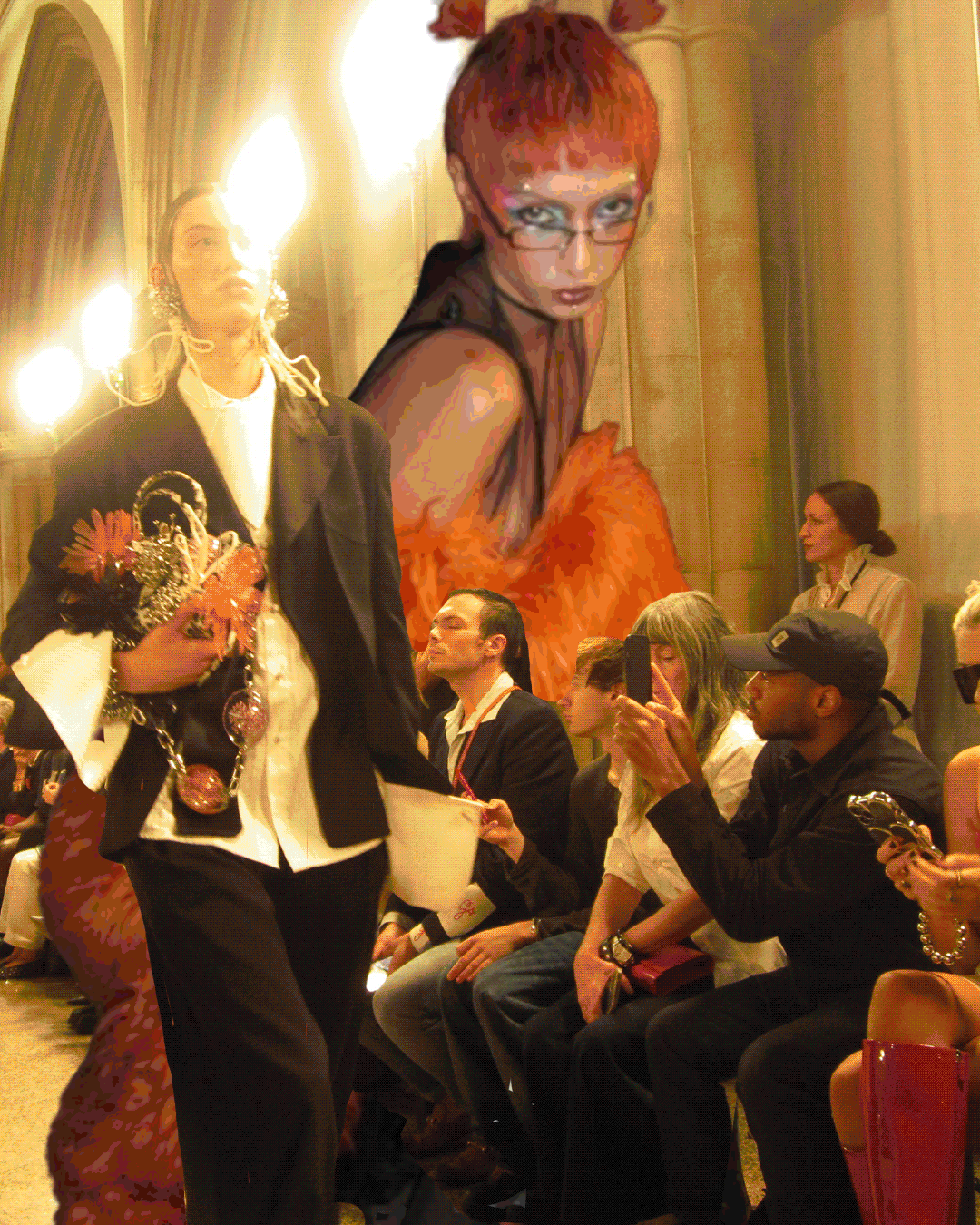Keeping Up With The Times
- Share via
With a dollop of disheveled blond curls crowning her head, a waist that looks to have been shaped by years of corseting, and perfectly porcelain skin, British fashion matriarch Vivienne Westwood could be dismissed as a kooky grandmother.
Thirty years after playing a major role in the punk movement in London with her ex-husband, Sex Pistols manager Malcolm McLaren, the 59-year-old designer has given up the rips, zips, chains and whips of her youth. “I’m older,” she says, “I’m not going to go ‘round in a bondage suit anymore.”
But she’s still got some kinkiness to her. Take the rocker T-shirt, emblazoned with the image of a woman spread-eagled, that she wore with a flouncy purple ball skirt at her picnic-style fashion show held last week in the garden of the Sunset Marquis in West Hollywood. She also likes to wear the naughty lingerie line Agent Provocateur, designed by her 32-year-old son, Joseph Corre, and his wife, Serena Rees. But only the bras. She’s strictly a no-knickers gal, a fact the world discovered in 1992, when she was photographed twirling in her skirts outside Buckingham Palace, where she had gone to receive her Order of the British Empire from the Queen.
In the 1970s, Westwood and McLaren believed they could wage a social revolution through fashion and rock ‘n’ roll from their Kings Road shop, which was alternatively named Let It Rock and Too Fast to Live, Too Young to Die. In 1974, they changed the store’s name to Sex to give a symbolic middle finger to the establishment that prosecuted them under British obscenity laws for making shirts with pornographic images.
These days, Westwood, who has a 3-year-old granddaughter, claims to do her best to ignore the outside world. “I don’t believe in progress,” she says with a detachment that comes with age and disappointment. “For me, it’s a matter of not keeping up with the times.”
She is just now understanding the celebrity-fashion connection, thanks to her handlers, who convinced her to come to L.A. and made sure Amanda DeCadenet, Roseanne and other celebs attended her show. “It’s been explained to me that these days, it’s not so much that you want Christy Turlington on the cover of your magazine,” she says, lighting one of many Gitanes cigarettes. “You want--well, I don’t know who you want.”
Westwood can’t fill in the blank with the name of a starlet du jour because she doesn’t read magazines or newspapers, watch television or see films. She retreats into books--historical and anthropological titles mostly.
Several pieces in her spring 2001 collection are made from a fabric with a bookbinder print. The pattern was inspired by bookshelves in her 1703 Clapham house, which once belonged to Capt. Cook’s mother. Westwood delights in describing how she took a photograph of the shelves to her fabric maker, who used a new photocopier-type machine to transfer the image directly to fabric.
Although the titles are hard to make out on the cotton jersey print dress and jacket, Westwood says one of them is Lord Raglan’s “The Hero,” which classifies characteristics of the classic hero based on archetypal tales.
For Westwood, life is something to be contemplated in grand terms. She realized by the late 1970s that she wasn’t a revolutionary; she was a victim. She gave up on punk, which, like the 1960s hippie look, had been co-opted and copied by big business.
“Punk was a heroic attempt at confronting the establishment,” she says. “But ultimately it failed.” To explain why, she paraphrases her manager, Carlo D’Amario, who said, “The establishment is a car going 100 miles an hour. You can throw blips at it and try to stop it, but you won’t bring it to a halt. It will only go faster with your energy.”
Her collaboration with McLaren ended soon after. “I outgrew him,” she says. “The difference between Malcolm and myself is that I didn’t want to just use whatever I was looking for to promote myself. I wanted to discover it for its own sake.”
She met her current husband and design collaborator, Andreas Kronthaler, when he was a student in a class she taught in 1989 at the Academy of Applied Arts in Vienna. He is 25 years her junior and “the most talented person I’ve ever met,” she says. “He has no ego.”
Westwood turns to the past for ideas for her collections, drawing inspiration from pirates, witches, 17th and 18th century European portraits and the French Revolution. Unlike so many seasoned fashion designers, she has not been approached by a luxury conglomerate offering to buy her name. “I’m sure if I wanted to, they’d exploit me. . . . I’m not at that point yet, but maybe I’d be interested eventually.”
Westwood insists that fashion, for her, has never been about mass marketing. It’s a way for people to establish identity. “I don’t pretend like it’s a crusade,” she says, “But to offer choice in an age of conformity is a powerful thing. . . . I could not go outside my house wearing anything from the Gap. I would feel like someone had taken my soul away.”
More to Read
The biggest entertainment stories
Get our big stories about Hollywood, film, television, music, arts, culture and more right in your inbox as soon as they publish.
You may occasionally receive promotional content from the Los Angeles Times.











